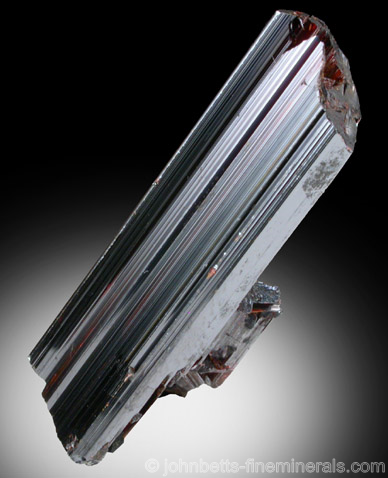The Mineral rutile

Rutile comes in a surprising contrast of distinct habits and colors, making it a very interesting mineral. It has multiple unique crystal forms as well as several telltale colors, styles, and associations. Rutile can range from mirror-like metallic-looking crystals, to dark reddish sub-metallic crystals, to bright golden-yellow needles. Even the opaque metallic-looking forms are somewhat translucent on edge under backlighting, with a dark red translucent tinge.
Rutile is well known for its habit of forming needle-like inclusions within other minerals, especially Quartz, in the form of long and slender yellow straw-like crystals. These inclusions can range from scattered needles to dense parallel fibers within a host mineral. This combination is known as Rutilated Quartz, and is used both as a collectors mineral and gemstone.
Rutile inclusions are also responsible for the
asterism or
chatoyancy effects on some gemstones, such as
Star Sapphire. The thin, parallel Rutile fibers that formed within the host mineral provide these unique optical effects.
Rutile is the most common mineral composed of titanium dioxide. Rarer
polymorphs include
Brookite and
Anatase, both which also form unique and distinctive crystals. The name Rutile is derived from the Latin "Rutilus", in reference to a common color habit of this mineral in dark red but lustrous crystals.
Color
Dark-red, metallic-gray, brownish-red, orange-red, reddish-black, golden-yellow, straw yellow
Crystal System
Tetragonal
Properties
Streak
White to light brown |
Hardness
6 - 6.5 |
Transparency
Translucent to opaque. Often transparent on thin edges and in backlighting. |
Specific Gravity
4.2 - 4.3 |
Luster
Adamantine, submetallic |
Cleavage
2,2;3,1 |
Fracture
Uneven |
Tenacity
Brittle |
Crystal Habits
As long and slender, straight prismatic crystals, often deeply striated and with steep complex terminations. Also in short prismatic and thick stubby crystals. Twinning is very common, with various forms including sixlings, eightlings (both in the form of endemic rutile twins), knee-shaped twins, and v-shaped twins.
Often in capillary needles and dense reticulated forms, in acicular habit, in delicate snowflake-like aggregates, and in star-shaped formations of dense needle groupings. Thin acicular crystals and needles are commonly frozen within other minerals, especially Quartz. May also be grainy, massive, in veins, and in rounded waterworn pebbles.
Additional Information
Composition
Titanium dioxide, often with iron, occasionally with some minor niobium or tantalum.
|
In Group
Oxides; Simple Oxides |
Striking Features
Color, crystal habits, luster, and high specific gravity. |
Environment
Rutile comes in several different environments, including plutonic and intrusive igneous rocks and granites, metamorphic gneiss and schists, carbonatites, regional metamorphic schists, and hydrothermal replacement deposits (including veins in alpine cavities). Also in detrital river and beach deposits.
|
Rock Type
Igneous, Metamorphic |
Varieties
-
Niobium bearing variety of Rutile.
-
Tantalum bearing variety of Rutile. Named after Italian mineralogist Giovanni Strüver (1842-1915), a professor at the University of Rome.
Uses
Rutile is an important ores of the metal titanium. Rutile is also industrially used as as a white pigment for paint, as a ceramic glaze, and in optical equipment. It is also a popular collectors mineral. Rutilated Quartz is used as a gemstone and as an ornamental stone.
Noteworthy Localities
Rutile is found in a host of different mineral deposits in hundreds of localities worldwide, but its occurrence is usually limited to small and isolated crystals. Several deposits are famous for producing excellent crystals; the most significant will be mentioned here.
Switzerland produces classic specimens in many of the mountainous alpine environments. These localities include the Binn Valley, Wallis (especially at the Lengenbach Quarry and at Lerchentini); the St. Gotthard pass, Ticino; and the Cavradi gorge, Curnera Valley, Grisons. Another important alpine European occurrence is the Vizze Valley, Bolzano, Italy.
The varieties Struverite and Ilmenorutile are found in large crystals in the Madagascar pegmatites at Antsirabe and Betafo, Antananarivo Province. Lustrous Rutile crystals come from Ribaue, in the Alto Ligonha pegmatite, Mozambique.
Brazil has several outstanding Rutile occurrences, including those that contain the most prolific Rutilated Quartz sources. The most exceptional of the Brazilian localities is Novo Horizonte (formerly Ibitiara), Bahia, which produces striking golden-yellow acicular and star-shaped formations associated with mirror-like Hematite crystals. Freestanding crystals and v-shaped twins occur in many of the Brazilian gem pegmatites of Minas Gerais; especially noteworthy is Diamantina, in the Jequitinhonha valley.
The U.S. contains several noteworthy sources of this mineral. The most famous is Graves Mountain, Lincoln Co., Georgia, where stubby, lustrous, mirror-like crystals were once found. Beautiful dark red and etched prismatic crystals come from Hiddenite and Stony Point, Alexander Co., North Carolina; and interesting sixlings and other twinned forms were well-known from the soils of Parkesburg, Chester Co., Pennsylvania, especially as floater crystals. Good Rutile crystals come from Magnet Cove, Garland Co., Arkansas, including Rutile pseudomorphs after Brookite. In California, two localities that have produced exceptionally lustrous stubby crystals are the Champion Mine, White Mountains, Mono Co.; and Darwin, Inyo Co.
Distingushing Similar Minerals
Cassiterite - Higher specific gravity, crystals not as lustrous as Rutile.
Schorl - Lacks reddish hue, much harder.